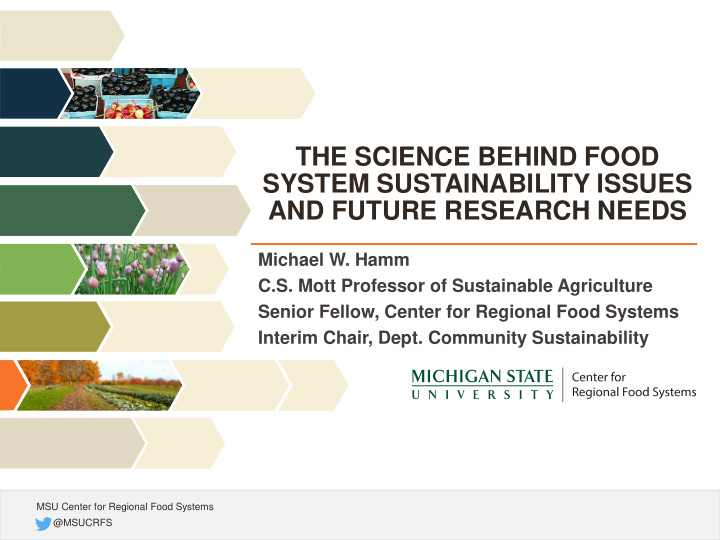



THE SCIENCE BEHIND FOOD SYSTEM SUSTAINABILITY ISSUES AND FUTURE RESEARCH NEEDS Michael W. Hamm C.S. Mott Professor of Sustainable Agriculture Senior Fellow, Center for Regional Food Systems Interim Chair, Dept. Community Sustainability MSU Center for Regional Food Systems @MSUCRFS
PLANETARY BOUNDARIES NOTION – IT’S NOT JUST ABOUT CARBON Rockstrom, J., Steffen, W., Noone, K., Persson, A., Chapin, F. S., 3rd, Lambin, E. F., . . . Foley, J. A. (2009a). A safe operating space for humanity. @MSUCRFS Nature, 461 (7263), 472-475.
IMPORTANT IN A GLOBAL CONTEXT @MSUCRFS
MEETING GLOBAL FOOD NEEDS WILL DEPEND ON FOUR CONCURRENT APPROACHES: 1) Altering individual and population dietary patterns; 2) Adopting existing and developing new agricultural production practices that reduce impacts and conserve resources; 3) More equitable distribution of resources; and 4) Reduction of food waste Adapted from: Garnett T. Food sustainability: problems, perspectives and solutions. Proc Nutr Soc. 2013 Feb;72:29–39 @MSUCRFS
DIETARY PATTERN AND CARRYING CAPACITY Peters, C. J., Picardy, J., Darrouzet-Nardi, A. F., Wilkins, J. L., Griffin, T. S., & Fick, G. W. (2016). Carrying capacity of U.S. agricultural land: Ten diet scenarios. Elementa: Science of the @MSUCRFS Anthropocene, 4 , 000116. doi:10.12952/journal.elementa.000116
CARRYING CAPACITY IS A FIRST STEP @MSUCRFS
FIG. 2. GHG EMISSIONS PER DAY ACCORDING TO THE 6 DIETS AND BROKEN DOWN INTO 7 FOOD GROUPS (FEMALE ADULTS). EH = ENERGY USE IN THE HOUSEHOLD PHASE. C. van Dooren et al. (2014) Exploring dietary guidelines based on ecological and Nutritional values: A comparison of six dietary patterns.Food Policy 44; 36–46. @MSUCRFS
Ovo-lacto vegetarian MSU Center for Regional Food Systems S. Soret et al (2014) Climate change mitigation and health effects of varied dietary patterns in real-life settings throughout North America. Am J Clin Nutr doi: 10.3945/ajcn.113.071589 @MSUCRFS
R.R.White and M.B.Hall (2017) Nutritional and greenhouse gas impacts of removing animals from US agriculture. www.pnas.org/cgi/doi/10.1073/pnas.1707322114 @MSUCRFS
R.R.White and M.B.Hall (2017) Nutritional and greenhouse gas impacts of removing animals from US agriculture. www.pnas.org/cgi/doi/10.1073/pnas.1707322114 @MSUCRFS
AND FROM THE UK… P. Scarborough et al (2014) Dietary greenhouse gas emissions of meat-eaters, fish-eaters, vegetarians and vegans in the UK. Climatic Change. 125:179 – 192 @MSUCRFS DOI 10.1007/s10584-014-1169-1
M.C. Heller & G.A. Keoleian (2014) Greenhouse Gas Emission Estimates of U.S. Dietary Choices and Food Loss. J.Ind.Ecol., 19:3, p. 391-401 @MSUCRFS
LOOKED AT GLOBALLY Tilman, D., & Clark, M. (2014). Global diets link environmental sustainability and human health. Nature, 515 (7528), 518-522. doi:10.1038/nature13959 @MSUCRFS
Tilman, D., & Clark, M. (2014). Global diets link environmental sustainability and human health. Nature, 515 (7528), 518-522. doi:10.1038/nature13959 @MSUCRFS
CONSIDERATIONS This doesn’t take into account variation in production strategies E.g. of beef and pasture v. grain E.g. of high-efficiency water use (trickle irrigation for e.g) Intra- vs inter- food item and sustainability The U.S. has a high calcium (hence dairy) recommended intake compared to most other countries – this complicates things in our case since 50% of total calcium consumption is from dairy in U.S. @MSUCRFS
HOW SOME OF OTHER VARIABLES BECOME IMPORTANT! MSU Center for Regional Food Systems Photo Credit: Dr. Jason Rowntree, Dept. Animal Sciences @MSUCRFS
BEEF AND U.S. POPULATION GROWTH Currently about 28 kg/person/yr MSU Center for Regional Food Systems @MSUCRFS
RUMINANTS, SYSTEMS, AND ?S - CAN RUMINANT GRAZING SYSTEMS HELP MITIGATE CLIMATE CHANGE? VS W.R. Teague, S. Apfelbaum, R. Lal, U.P. Kreuter, J. Rowntree, Tilman, D., & Clark, M. (2014). Global diets C.A. Davies, R. Conser, M. Rasmussen, J. Hatfield, T. Wang, link environmental sustainability and human F. Wang, and P. Byck (2016) The role of ruminants in reducing health. Nature, 515 (7528), 518-522. agriculture’s carbon footprint in North America . J.of Soil and @MSUCRFS doi:10.1038/nature13959 Water Conservation. 71:2, p. 156-164.
ADAPTIVE MULTI-PADDOCK GRAZING VS. FEEDLOT FINISHING Net GHG Flux Without Soil C Flux With Soil C flux 12 9.62 10 8 6.09 6.12 6 Kg CO2-e kg CW-1 4 2 0 -2 -4 -6 -6.65 -8 AMP FL P.L.Stanley, J.E.Rowntree, D.K.Beede, M.S.DeLonge, & M.W.Hamm (2018) Impacts of soil carbon sequestration on life cycle greenhouse gas emissions in Midwestern USA beef finishing systems. @MSUCRFS Agricultural Systems 162 (2018) 249–258
SOIL CARBON LEVELS IN 1981 AND 1995: RODALE FST Drinkwater, L.E., Wagoner, P., & Sarrantonio, M. (1998) Legume-based cropping @MSUCRFS systems have reduced carbon and nitrogen losses. Nature, 396, p 262-265
E.G. RELATIVE LOCATION OF PRODUCTION MSU Center for Regional Food Systems Photos from: MSU Student Organic Farm @MSUCRFS
@MSUCRFS
@MSUCRFS
Slide from Dr. Bruce Bugby, Utah State University @MSUCRFS
E.G. OF WATER - NEW YORK METRO – WATER FROM LOW TO HIGH WATER AREAS Modeling research showed 70% of NYC food needs could be met with respect to dairy, eggs, fruits, vegetables from NY State* *Peters, C. J., et al. (2007). "Testing a complete-diet model for estimating the land resource requirements of food consumption and agricultural carrying capacity: The New York State example." Renewable Agriculture and Food Systems 22 (02): 145. @MSUCRFS
DIETARY PATTERNS AND NUTRIENTS Challenge of ‘tonnage’ of food needed Consuming 50% more – approximately dietary recommendations @MSUCRFS
CHALLENGE OF SCALE Back of the Envelope Calculations – M.W. Hamm (2015); Current from 2012 USDA Census of Agriculture @MSUCRFS
DIETARY PATTERNS AND PROTEIN Insect protein and palatable foods Species, diet, micronutrient potential Use of indoor space Challenges from production to processing to consumer acceptance @MSUCRFS
CONCLUSION - FOUR RECOMMENDATIONS IN DGAC REPORT Conduct research to determine whether sustainable diets are affordable and accessible to all sectors of the population ... Develop, conduct, and evaluate in-depth analyses of U.S. domestic dietary patterns and determine the degree to which sustainability practices, domestically and internationally, are important to food choice … Develop a robust understanding of how production practices, supply chain decisions, consumer behaviors, and waste disposal affect the environmental sustainability of various practices ... Determine the potential economic benefits and challenges to supply chain stakeholders … @MSUCRFS
The End @MSUCRFS
Recommend
More recommend